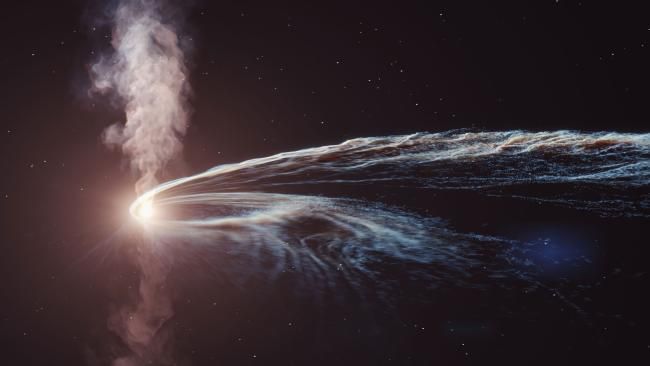For years, we have known black holes as mysterious objects that consume whatever comes around their event horizon without burping out anything from their inside. However, astronomers were fascinated with the recent discovery of a black hole spewing out the remains of a star it devoured three years ago. In October 2018, astronomers observed a black hole located approximately 665 million light years from Earth consuming a star that moved too close to its event horizon. Although astronomers were fascinated by this event, they were not surprised as they have witnessed many encounters between stars and black holes in the past.
Almost three years after ripping apart this star, that same black hole was discovered lighting up the skies with the star’s remains. Scientists revealed that the blackhole hasn’t consumed anything since 2018. Hence, they are sure that the black hole is actually vomiting the star it consumed three years earlier. A team of Harvard Scientists led by Yvette Cendes, a research associate at the Center for Astrophysics | Harvard & Smithsonian (CfA), conducted this new study and were amazed by the outcome.
“This caught us completely by surprise — no one has ever seen anything like this before,” says Yvette Cendes.
Based on data collected from observing this event, the team finalized that the black hole is currently emitting materials moving at almost half of the speed of light. However, they have always wondered by it took the blackhole years before ejecting the star it consumed earlier. In fact, scientists across the world have never seen anything like this before.
How the team of scientists conducted the research
Scientists across the world understand that black holes possess the ability to consume any object that comes closer to its event horizon. The process whereby a star is consumed while making a closer approach to a supermassive black hole is referred to as tidal disruption events (TDEs). Scientists often use highly sophisticated telescopes to observe this event from the earth.
A team of scientists recently visited the Very Large Array (VLA) in New Mexico to analyze tidal disruption events (TDEs) happening in the Cosmos. While analyzing the radio data observed by the telescope, they discovered the unusual outburst and were amazed by it. The data also revealed that the blackhole had strangely reanimated in June 2021. The team of scientists was inspired to study the event even further to obtain more information.
“We applied for Director’s Discretionary Time on multiple telescopes, which is when you find something so unexpected, you can’t wait for the normal cycle of telescope proposals to observe it,” Cendes explains to discovery. “All the applications were immediately accepted.”
To obtain more data from the observation, the team analyzed the AT2018hyz data and the recent observations of TDE in multiple wavelengths using instruments of the VLA, MeerKAT in South Africa, the Chandra X-Ray Observatory, the ALMA Observatory in Chile, the Neil Gehrels Swift Observatory in Space, and the Australian Telescope Compact Array in Australia. Based on their radio observations, the team was more fascinated with the outcome of this new study.
“We have been studying TDEs with radio telescopes for more than a decade, and we sometimes find they shine in radio waves as they spew out material while the star is first being consumed by the black hole,” says Edo Berger, professor of astronomy at Harvard University and the CFA, and co-author on the new study. “But in AT2018hyz there was radio silence for the first three years, and now it’s dramatically lit up to become one of the most radio-luminous TDEs ever observed.”
Generally, TDEs often emit light whenever they occur. When a star moves closer to a blackhole, strong gravitational forces will start to stretch out the star. Because of this powerful stretch, the elongated materials of the star will begin to move around the black holes and eventually heats up. This occurrence will create a unique flash of light at astronomers can observe from millions of light years away from earth.
Over the years, scientists have discovered that some spaghettified material of a stellar object may be discharged back into space, as black holes exist as messy eaters. This implies that not every part of the star they attempt to eat passes through their mouths. Some remaining parts of the object will be thrown back into space. However, the emission of the remaining undigested materials is often thrown black into space immediately after a TDE occurs.
Astronomers have not witnessed an outflow that takes years to occur. Hence, while analyzing the outcome of this event, scientists conclude that the black hole appears to be burping out a part of the star it consumed years ago. The team of scientists carefully analyzed the outflow and concludes that it travels up to 50 percent of light speed. But Cendes says that this is quite unusual as most TDEs create an outflow that moves at 10 percent of the speed of light.
“This is the first time that we have witnessed such a long delay between the feeding and the outflow,” Berger says. “The next step is to explore whether this actually happens more regularly and we have simply not been looking at TDEs late enough in their evolution.”
Conclusion
This new study will help astronomers across the world to understand more about how black holes eat stars and digest them according. The team of scientists published the outcome of the new study in the Astrophysical Journal. What do you think about this fascinating discovery?




